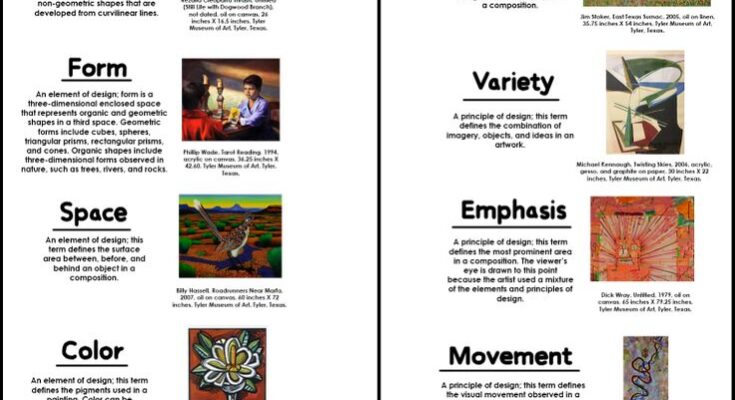Understanding the Elements and Principles of Design: A Visual Journey
Embark on a captivating exploration of the foundational components that shape artistic expression with this detailed guide to the Elements and Principles of Design. Featuring a rich collection of artworks from the Tyler Museum of Art, Texas, this tutorial pairs stunning visual examples with comprehensive descriptions, making it an invaluable resource for artists, designers, and art enthusiasts. Whether you’re honing your craft or deepening your appreciation of visual composition, this guide offers a thorough understanding of how these elements and principles work together to create impactful art.
Elements of Design
The Elements of Design form the building blocks of any artwork, each contributing unique qualities:
- Line: An essential element, line is a point moving with direction, width, and texture. Lines can be vertical, horizontal, diagonal, zig-zag, or curved, as seen in Angel F. Nenn’s Landscape with Victorian Cottage and Gazebo (1984), where varied lines define the structure and landscape.
- Shape: This two-dimensional enclosed space represents either an organic shape or a geometric form, including squares, circles, rectangles, triangles, and more. Reata Cleopetra Brooks’ Untitled (1981) showcases organic shapes with natural, flowing contours.
- Form: Extending shape into a three-dimensional space, form includes cubes, spheres, triangular prisms, rectangular prisms, and natural forms like trees, rivers, and rocks. Phillip Wade’s Lizard Bearing (1994) illustrates this with a sculpted, three-dimensional figure.
- Space: This term defines the surface area between, behind, and around objects and shapes within a composition. Billy Hassell’s Roadrunners Near Marfa (1997) uses space to create depth and perspective in the desert landscape.
- Color: An element of design, color is the spectrum applied in a painting, organized into categories such as hues, values, complements, and intensities. David Bates’ Magnolia and Lemon (1999) highlights vibrant color use with organic shapes on Japanese paper.
- Value: The spectrum of a hue, value indicates the lightness or darkness of a color, ranging from white to black with intermediate hues. Margie Crisp’s Patton (1977) employs value to create contrast and depth in a charcoal drawing.
- Texture: The surface quality of an artwork, texture can be actual (tactile) or implied (visual). Mihailo Vukelic’s Influence (2001) features a bronze relief sculpture with a pronounced, tangible texture.
Principles of Design
The Principles of Design guide the arrangement and interaction of the elements to achieve a cohesive artwork:
- Balance: This principle defines the arrangement of the design’s elements of design. It refers to either asymmetrical or symmetrical compositions. Donald S. Vogel’s Self Portrait (1989) demonstrates balanced composition with a harmonious layout.
- Unity: A principle that defines how the elements and principles of design are combined within a composition. Jim Nutt’s Edna (2000) exemplifies unity with a seamless integration of shapes and colors.
- Variety: This principle involves the combination of imagery, objects, and ideas in an artwork. Michael Frary’s Tuscan Countryside (2006) showcases variety through diverse elements and textures.
- Emphasis: A principle of design, emphasis draws attention to a specific area in a composition. The viewer’s eye is drawn to this point because the artist used a mixture of the elements and principles of design. Dick Wray’s Untitled (1979) uses bold colors and lines to create a focal point.
- Movement: This principle of design is defined as the visual movement observed in a painting. This can be identified as kinetic movement or implied movement and can be defined as how the viewer’s eye moves throughout the composition. Liz Ward’s Ghost of the Old Mississippi Bottom (1995) guides the eye with flowing, dynamic lines.
- Pattern: A principle of design, this term defines the repetitive imagery and elements of design found in a composition. Vincent Falsetta’s Untitled (2005) features a repetitive pattern that adds rhythm and structure.
- Proportion: This principle of design defines the comparative size relationship between objects in an artwork. It refers to the size relationship between a painting or a sculpture and a real object. Frank Dudley’s Black-Necked Stilt (1916) illustrates proportion with a lifelike representation of the bird.
Practical Insights for Artists
This guide encourages you to study these elements and principles in action by analyzing the provided artworks. Experiment with lines, shapes, and colors to explore balance and unity, or use emphasis and movement to direct the viewer’s eye. Texture and proportion can add realism and scale, while variety and pattern enhance complexity. Practice combining these concepts to develop your unique style.
Posted on July 04, 2025, at 04:30 AM EDT, this tutorial invites you to visit the Tyler Museum of Art or use these examples as inspiration for your next project. Whether you’re sketching, painting, or sculpting, mastering these elements and principles will elevate your artistic vision and execution!



